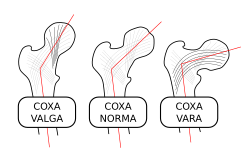Trabecular tissue
| Trabecula | |
|---|---|

Alternation of trabecular pattern in the thigh bone reflects mechanical stress
|
|
| Details | |
| Part of | Bone |
| Identifiers | |
| FMA | 85273 |
|
Anatomical terminology
[]
|
|
A trabecula (plural trabeculae, from Latin for "small beam") is a small, often microscopic, tissue element in the form of a small beam, strut or rod that supports or anchors a framework of parts within a body or organ. A trabecula generally has a mechanical function, and is usually composed of dense collagenous tissue (such as the trabecula of the spleen). They can be composed of other materials such as muscle and bone. In the heart, muscles form trabeculae carneae and septomarginal trabecula.Cancellous bone is formed from groupings of trabeculated bone tissue.
In cross sections, trabeculae of a cancellous bone can look like septa, but in three dimensions they are topologically distinct, with trabeculae being roughly rod or pillar-shaped and septa being sheet-like.
When crossing fluid-filled spaces, trabeculae may have the function of resisting tension (as in the penis, see for example trabeculae of corpora cavernosa and trabeculae of corpus spongiosum) or providing a cell filter (as in the trabecular meshwork of the eye).
Multiple perforations in a septum may reduce it to a collection of trabeculae, as happens to the walls of some of the pulmonary alveoli in emphysema.
...
Wikipedia
